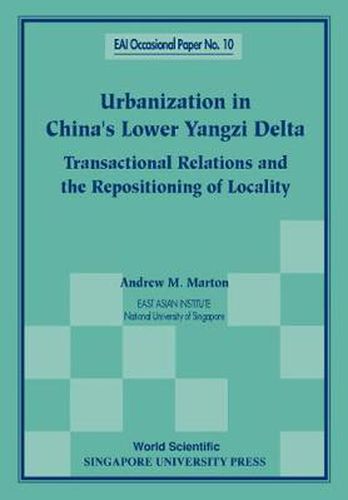Readings Newsletter
Become a Readings Member to make your shopping experience even easier.
Sign in or sign up for free!
You’re not far away from qualifying for FREE standard shipping within Australia
You’ve qualified for FREE standard shipping within Australia
The cart is loading…






The development of market socialism in China has contributed to remarkable spatial economic transformations in particular areas of the Chinese countryside. The conventional wisdom of existing theories of urban transition does not adequately explain the emergence of these open textured landscapes of mixed agricultural and non-agricultural activities. This paper examines some of the key processes and mechanisms of regional restructuring in one country level jurisdiction in the lower Yangzi delta. A case study of Kunshan situates the emergence of specific patterns of industrial production within a complex network of interactions and interrelationships embedded in overlapping administrative and institutional structures which are themselves largely tied to the circumstances of particular places. Two central findings are revealed. First, the patterns and underlying processes and mechanisms of regional development in the delta are fundamentally linked to intensely localized exigencies and opportunities within the wider space economy. Second, external economies, the dynamics of agglomeration, and the role of large cities and other exogenous forces, while significant, were less important in the delta than were endogenous forces. Highlighted are a number of issues which need to be accommodated in a new conceptual framework for understanding and explaining urbanization in China’s lower Yangzi delta. The paper concludes by outlining a planning and management agenda which responds to the resulting conceptual and analytical shift in emphasis.
$9.00 standard shipping within Australia
FREE standard shipping within Australia for orders over $100.00
Express & International shipping calculated at checkout
The development of market socialism in China has contributed to remarkable spatial economic transformations in particular areas of the Chinese countryside. The conventional wisdom of existing theories of urban transition does not adequately explain the emergence of these open textured landscapes of mixed agricultural and non-agricultural activities. This paper examines some of the key processes and mechanisms of regional restructuring in one country level jurisdiction in the lower Yangzi delta. A case study of Kunshan situates the emergence of specific patterns of industrial production within a complex network of interactions and interrelationships embedded in overlapping administrative and institutional structures which are themselves largely tied to the circumstances of particular places. Two central findings are revealed. First, the patterns and underlying processes and mechanisms of regional development in the delta are fundamentally linked to intensely localized exigencies and opportunities within the wider space economy. Second, external economies, the dynamics of agglomeration, and the role of large cities and other exogenous forces, while significant, were less important in the delta than were endogenous forces. Highlighted are a number of issues which need to be accommodated in a new conceptual framework for understanding and explaining urbanization in China’s lower Yangzi delta. The paper concludes by outlining a planning and management agenda which responds to the resulting conceptual and analytical shift in emphasis.